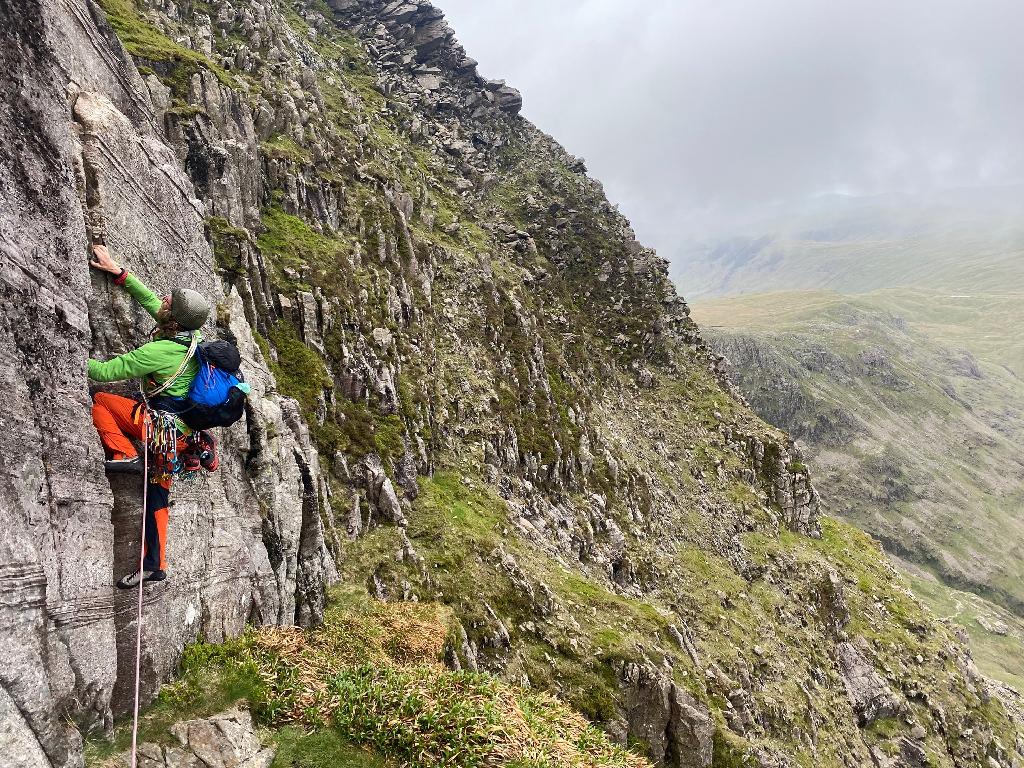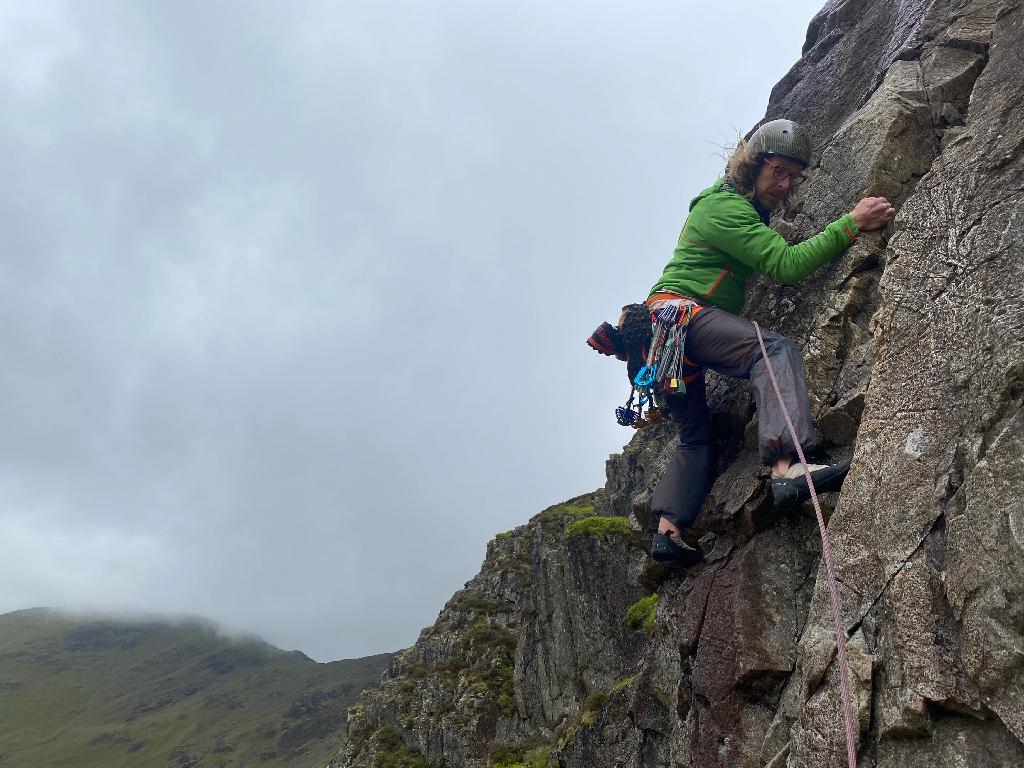Lake District Classic Rock Challenge
Posted by Jeremy Windsor on Sep 23, 2022
A copy of "Classic Rock" has sat on my shelves for many years. For those of you who don't know it, the book is a collection of essays that describe more than 80 of the best climbs in England, Scotland and Wales. But it's much more than just a guidebook. As an early reviewer once wrote, "This is a fine book, packed with good reading and good climbing, dreams and reminiscences, resource and adventure – the very stuff of the climbing game". And so inspired by the book, earlier this year Miles Gibson and I had a stab at climbing all 15 Lake District "Classic Rock" routes in a single, unsupported push. Of course, we weren't the first. Back in 1994, Mike Van Gullich, Tim Gould and Dave Willis climbed all of the routes in a time of 23 hours and 59 minutes. Many more sub-24 hour rounds have followed, including the dazzling effort of Shane Ohly who currently holds the record in a time of 9 hours and 22 minutes. However, Miles and I decided that a race against the clock wasn't for us and over the course of three days in May 2022 we set off on our very own adventure. This is what we learnt along the way...
Be Prepared...
The bare facts give you an idea of what to expect. Linking all 15 of the "Classic Rock" routes together on foot means covering almost 55kms of mountainous ground. Throw in the ever changing Lake District weather and the fact that there's 60 or so pitches of climbing, then the size of the challenge starts to become clear. For me to have any chance, I needed to put in a bit of preparation. This began one evening in lockdown by spreading out all of my Lake District maps and guidebooks on the kitchen table. From this a plan - using just 3 books! - slowly emerged. Despite having climbed all of the routes in the past it soon became clear that I needed to go back and do many of them again. Not only had I forgotten the details of each climb, but I could barely remember where they started, or for that matter, where they finished. This was where, "Mountain Rock" by Steve Broadbent, came to my aid. Thankfully, all 15 routes were thoroughly covered - so whether it was the length of the abseil off the top of Jones' Route or directions to the unlikely down climb beside Tophet Wall, this book had all the answers. Meanwhile, "Walking The Wainwrights" by Stuart Marshall, helped me build up the stamina that I needed in my legs. Rather than trot aimlessly around the Peak District it provided me with ideas for dozens of days in the Lakes and as a byproduct, helped me tick off more than a hundred Wainwrights along the way. Finally, "Scrambles in the Lake District" by John Fleetwood, pointed me towards a series of long easy routes that improved my movement over rocky ground. This also had the added benefit of giving me the chance to find the best paths, camping spots and water sources that would be needed for what lay ahead.
The benefits of preparation were felt right from the start. After a quick climb up Murray's Route on Dow we found the most direct line to Langdale and made it in good time to the foot of Gimmer. Still fresh, we were able to whizz up the next 3 routes and head over to Bowfell before the heavens opened. After so many months of preparation we had finally made a start. But there was still a lot more that needed to be done...

Miles leading the crux pitch of Bowfell Buttress at the start of the second day
Light Is Right...
I knew from the beginning that I was never going to do the whole round in under 24 hours. I simply couldn't run that far and still be in good enough shape to climb quickly, sometimes solo, sometimes in the dark, all 15 "Classic Rock" climbs. A sleeping bag, mat and tent were therefore going to be needed. Rack and ropes too, not to mention, a large amount of food and water. Whilst these extra 5 or 6 kgs might not sound like too much, they would inevitably lead to a second and possibly a third night out in the fells. The obvious answer was to take more. But as the growing pile of kit and food started to grow, it looked like a porter was going to be needed. It all began to sound like a scene from, "The Ascent of Rum Doodle". Perhaps a second porter would be required to carry the kit of the first? The cuts, when they finally came, were brutal. First up, all the spares were ditched. Dry socks, a change of underwear and a clean shirt were all abandoned. I was going finish in the clothes that I would start in, no matter how long it would take. A stove and fuel were also jettisoned. So too, a long list of "bits and pieces" - from gloves and chalk bag to anything to do with personal hygiene. Food was cut to a minimum. I reasoned, somewhat foolishly, that climbing towards the end would have to be done on an empty stomach. A Patagonia R1 was my one concession to warmth. Otherwise it was lightweight running waterproofs, thin climbing trousers and the lightest of belay jackets. If extra warmth was needed- and it often was - then I'd wear the waterproof trousers. On my feet, I wore a pair of lightweight fell running shoes with the thinnest waterproof socks. To finish things off, I borrowed a lightweight helmet and a very flimsy sports climbing harness. Miles, with similar zeal, had sourced 40m of the thinnest rope I have ever seen and a rack that included a set of lightweight cams and nuts, some skinny slings and half a dozen of the world's smallest runners. Finally, to save a bit more weight we also shared some kit - I packed a map and compass, whilst Miles carried a small battery to charge our mobile phones.
Our first night's camp site was on a small patch of grass at the foot of Bowfell Buttress. Heavy rain had stopped us in our tracks. With only 4 out of 15 routes done, we'd covered a lot of ground but had little to show for it. But setting off the next day, the sacks were light and the climbing seemed pretty straightforward. Even in our tired state, it wasn't the weight of our rucksacks that would cause us to fail. Perhaps it would be something else...

Abseiling from the top of Jones' Route on Scafell
Do What You Do Best...
By the time we set off I could say with some confidence that I knew the way. It proved to be a good thing as Miles hadn't climbed any of the Lakes' Classic Rock routes before. In fact he couldn't remember the last time he'd climbed below E1. Navigation was therefore down to me. But what about the climbing? Let's be clear. When time and energy are in limited supply, what's the point of a high E grade climber seconding someone who's never led beyond HVS? There's no point. Miles has climbed some of the hardest routes in the Peak District. The roles were obvious. I would get us on and off the routes, Miles would get us up them! A routine was soon set. I would find the start, uncoil the rope and pass Miles a laminated photocopy of the route. With a few words of descripton I'd finish by saying something like, "basically, follow the line of least resistance" and he would disappear off at an impressive rate. Rarely have I given out rope at such speed. In fact, my ability to pass the rope through the belay plate was often the limiting factor to upward progress. But it should be said that Miles didn't always follow the exact line. Can those who lead high E grades discriminate between VDiff and VS? I suspect not - It must all seem pretty straightforward! Sometimes this meant that Miles took a harder line than was absolutely necessary but since he rarely placed any gear it was always possible to follow him.
Most of the time we moved together, with climbs being done in just one or two pitches. This meant that much of our second day passed in a blur. No sooner had we done the routes on Scafell than we were over to Gable and topping out on Needle Ridge. But the weather was starting to change. Would we still make it?

Miles leading the crux pitch of Gillercombe Buttress as heavy rain started to fall...
It's All In The Mind...
For all that I've written about practical matters - the preparation, gear and tactics - the real key to success lies somewhere else. As daylight faded on the second day we pitched our tent on a grassy platform just below Robinson's Cairn. Unfortunately the weather forecast had changed. Instead of just a shower or two, we were now faced with a long spell of heavy rain. Whilst we'd dodged most of the previous day's showers, there had been a few patches of damp rock. The traverse of the first pitch of Jones's Route had been particularly memorable. But heavy rain? That meant cold running water and a soaking at best. Surely that would shut us down? With food supplies running low and fatigue setting in we were beginning to doubt ourselves. What was needed was a bit of ... well, determination.
Reading the forecast in more detail it soon became clear that the rain was set to arrive by mid morning and continue until late into the afternoon. Our best chance of success lay in climbing the two routes on Pillar before dawn and then heading over to Brandreth and taking a look at Gillercombe Buttress. Steve Broadbent's guidebook offered some hope, "The rock is generally clean and can be climbed in wet conditions...". Perhaps if the rain eased we could somehow get up it and find drier conditions later in Borrowdale? At least that was the plan. Shortly before 3am we woke and headed over to Pillar. With thick mist swirling around us we took a little longer to find High Man than planned. Nevertheless, once roped up we made rapid progress, taking little more than an hour to tick off both climbs. Back at the tent we had a frugal breakfast and set off back towards Gable and our final trio of routes. Heavy rain and strong winds soon joined us. The forecast was spot on. We didn't say much and just kept going. Nearly two hours later we arrived at the foot of Gillercombe Buttress. Although the wind had picked up, the rain had eased to a drizzle.
"We've got this", Miles said. He lead off slowly, testing holds and carefully arranging gear. Eventually I followed, skidding and heaving, doing my best to stay upright. At one or two points the rock started to dry and our speed increased. But with the finish in sight everything changed. Dark clouds encircled us and the wind picked up. Once the rain started to fall there was nowhere to hide. Water started running in waves down the rock and gusts of wind blasted freezing spray up from below. Seconding the crux was an extraordinary experience - it felt like standing in a car wash and being doused from all sides. Desperately, I clung on and eventually found Miles at the top huddled between rocks, shielding himself from the elements. Despite the conditions we were both smiling broadly. At that point we knew we were going to finish.
Ahead of us lay the long walk over to Borrowdale. On arriving at Seathwaite the clouds cracked apart and the sun came out. Despite still being wet, we quickly climbed Troutdale Pinnacle and all that remained was Little Chamonix. There couldn't have been a better climb to finish on! Romping up the final pitch on glorious steep holds felt like an early start to the celebrations. We'd done it.
In the end, it was the determination of two climbers (one very good one!) that had been the key!
Thanks to Steve Atkinson, Damian Thacker and most of all, Miles Gibson.
Interested in climbing? Read a review of Paul Pritchard's new book here. What about an interview with "The Sharp End" podcaster Ashley Saupe or "Snow And Ice" author Lina Arthur? A history of a fascinating ice axe? Or what about some tips on winter climbing in the Peak District?
Comments
Leave a comment.
Leave a comment.



 )
)